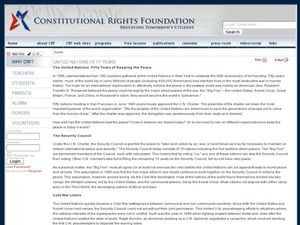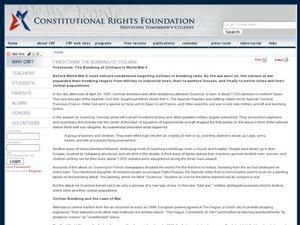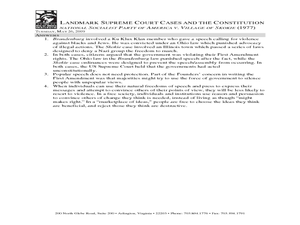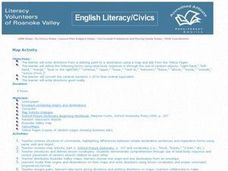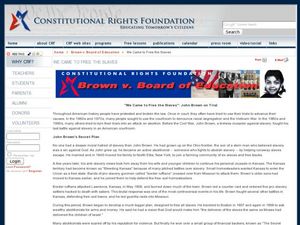Curated OER
US Patriot Act: Security vs. Privacy
Students use readings, worksheets and discussion to explore the ramifications of the US Patriot Act which was passed by Congress shortly after September 11th. They review Constitutional Amendments and consider how they relate to the...
Curated OER
The United Nations: Fifty Years of Keeping the Peace
Students examine the work of the United Nations. For this United Nations lesson, students listen to their instructor present a lecture regarding the history of the United Nations. Students respond to discussion questions pertaining to...
Curated OER
Firestorms: The Bombing of Civilians in World War II
Young scholars examine the implication of civilian targets in war. In this World War II lesson, students investigate the history of bombing practices in war. Young scholars zero in on World War II bombing practices as they discuss...
Curated OER
Emerging Democracies in Eastern Europe and Russia: How Are They Doing?
High schoolers consider the success of democracies in Eastern Europe. In this government systems instructional activity, students research the implementation of democratic practices and rule in the countries of Eastern Europe following...
Visa
In Trouble
What are some of the financial risks associated with using credit? Pupils learn the warning signs of incurring financial hardship, and through PowerPoint presentations, worksheets, and discussion, discover the implications of such events...
Visa
The Tools to Build Your Financial Dream
When it comes to all the ways money management and financial responsibility weave into our daily lives as adults, make sure students are prepared to locate resources for managing their finances, such as a financial advisor.
Curated OER
Constitution Cartoons
Young scholars view series of cartoon overheads that explain Constitution, name branches of government and their powers, define federalism and separation of powers, examine rights and obligations of citizens, and discuss significance of...
Curated OER
What is Democracy?
Students explore the facets of democracy. In this civic responsibility activity, students create a definition of democracy and discuss the difference between a spectator and a participatory citizen. Students discuss whose...
Curated OER
Landmark Supreme Court Cases and the Constitution: National Socialist Party of America v. Village of Skokie (1977)
Students examine the impact of court decisions. For this Supreme Court lesson, students read the National Socialist Party of America v. Village of Skokie (1977) case study regarding First Amendment Rights. Students take notes on the case...
Curated OER
Our Compromise, Our Constitution
Sixth graders explore, analyze and study our constitutional government and become aware of the purpose of our government. They assess the basic rights that are protected by the United States Constitution through graphic organizers and...
Curated OER
The Preamble to the U. S. Constitution
Fifth graders explain the purpose of the government by examining the Preamble to the Constitution. They identify ways in which the government is preserving those rights today. They discover one of the fundamental principles of...
Curated OER
A Civic Duty to Protest
Students examine the concept of religious freedom by evaluating Hong Kong's security laws. In pairs students investigate the levels of religous freedom allowed in various countries around the world and present this information to the class.
Curated OER
The Patriot Act: What Is the Proper Balance Between National Security and Individual Rights?
Students discuss the Patriot Act and are given questions at the end of the lesson to respond to.
Curated OER
Right on the Money
Young scholars watch a video about different ways of making the same amounts of money and view a clip about the Denver Mint to discover how coins are made. They complete a Web activity on each coin's worth and find out facts about the...
Curated OER
Money Talks
Students examine paper money from the time of the American Revolution. They use the issue dates of the bills to construct a chronology of political changes during the Revolution.
Curated OER
The Role of the Executive Branch in the Lawmaking Process
Students research the Executive Branches role in making a law. In this law making lesson plan, students study the history of the Constitution and see how much power the President has in making a bill into a law. Students then research on...
Curated OER
Money Booklet
Students practice handling money by examining different world currency. In this economics instructional activity, students utilize a coin booklet to trace individual coins and draw bills, later coloring them in their traditional colors....
Curated OER
Map Activity - Roanoke Valley
Students write directions from a starting point to a destination using a map and ads from the Yellow Pages. They define the following terms using total body response or through the use of random objects: "right-hand," "left-hand,"...
Curated OER
VA Statute for Religious Freedom, III
Students analyze the Virginia Statute for Religious Freedoms and consider its implications. In this governing principles lesson, students explore primary and secondary sources regarding the document penned by Thomas Jefferson.
Curated OER
The Adarand Case: Affirmative Action and Equal Protection
Eleventh graders examine the Adarand case. In this American Government lesson, 11th graders create a list of reasons for each affirmative action program. Students develop a defense on certain issues and present it to the class.
Curated OER
Three Visions for African Americans
Students consider the plight of African Americans in post-Reconstruction America. In this African American history lesson, students discover the visions of African American leaders Booker T. Washington, W. E. B. Du Bois, and Marcus...
Curated OER
"We Came to Free the Slaves": John Brown on Trial
Students explore the plight of John Brown to fight slavery. In this Brown vs. Board of Education lesson, students listen to a lecture regarding Brown's work to free slaves through rebellion. Students participate in classroom discussion...
National Endowment for the Humanities
NAACP's Anti-Lynching Campaign in the 1930s
Students examine the anti-lynching campaign sponsored by the NAACP in the 1930's. In this social justice lesson, students study the history of the anti-lynching campaign and determine why it was not successful. Students conduct research...
Curated OER
SHARK BODY PARTS
Learners list all the parts on the shark and label a diagram of the shark anatomy. They define the words, "gill and fin" and describe what they are used for.



